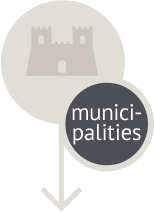The origin of the church can be traced back before the XI century A.D, approximately under the Lombard domination. In fact, the church is dedicated to the Archangel Michael, the Lombard’s patron. In 1357, the church was rebuilt through the proceeds of an emphyteusis stipulated with the Municipality and took the forms of today. San Michele’s church has a floor plan with three naves of equal height, marked by rectangular pillars with pointed arches and wooden trusses. Square apses conclude the naves, hosting the altars arranged in a parallel Cistercian matrix. The apses are covered by masonry vaults and lit by high trefoil windows. The internal walls were plastered in 1828 and during subsequent restorations, fragments of frescos were emerged dating back XIV and XV century. The altar is made up of little columns and arches of two types of geometrical patterns, inspired by the frescos on the walls. In the middle of the major apse, a painting by Andrea Aquilini from Jesi, which dates back to 1525, portrays the wedding between Jesus and Saint Catherine from Alessandria and God giving the wedding ring to the Saint. On the right side altar, there is "Madonna del Buon Consiglio". On the left, on the altar of Santissimo, you can see "Madonna delle Grazie", a fragment of fresco that miraculously survived intact although it broke away from the wall. In the late XIX century, some prodigious events as the end of brawls and the conversion of those who bowed down in front of him are linked to this fragment of fresco. On both internal and external walls are placed several tombstones and inscriptions of various periods and different functions. Saint Michael’s Church was a parish until 1991; it has recently welcomed the monastic order of "Servi di Maria": they take care, preserve and pray inside the histirical building.
THE LOMBARD
It was a Lombard tradition that each castle had its church: it’s testified by the fact that in Montecchio, to the “Castello dell'Elce” (where now there is the hospital) was added the Church of San Giacomo, later ruined. Cassero had the church of Santa Maria a Mare, that is “dell’Assunta” (more or less the place of the actual Theatre), the castrum inferius had the church of San Giovanni Battista (the actual cathedral), all the saint protectors of Lombard population.
"San Michele era una chiesa più antica di Scolastica, buia, sguarnita, mattoni, pietra e brandelli di pitture scolorite; il soffitto tenuto su da cavalletti di legno;
niente dorature, niente angioletti, niente odore d'incenso, una chiesa quasi spelonca che Zizì diceva bellissima ...
L'orto annesso era la fine del paese che, come edifici, chiudeva con San Michele e la sua casa. La fine di un paese, per quanto appuntita, è sempre la conclusione di un paese; l'orto di San Michele era quella fine ...
In tutta la mia vita mai avuta a disposizione una campagna grande come quell'orto".
Da “Giù la piazza non c’è nessuno” di Dolores Prato






